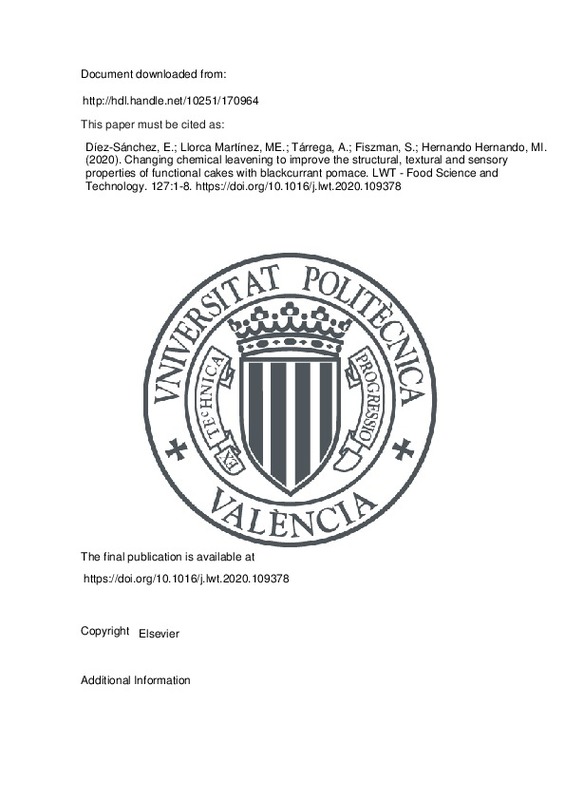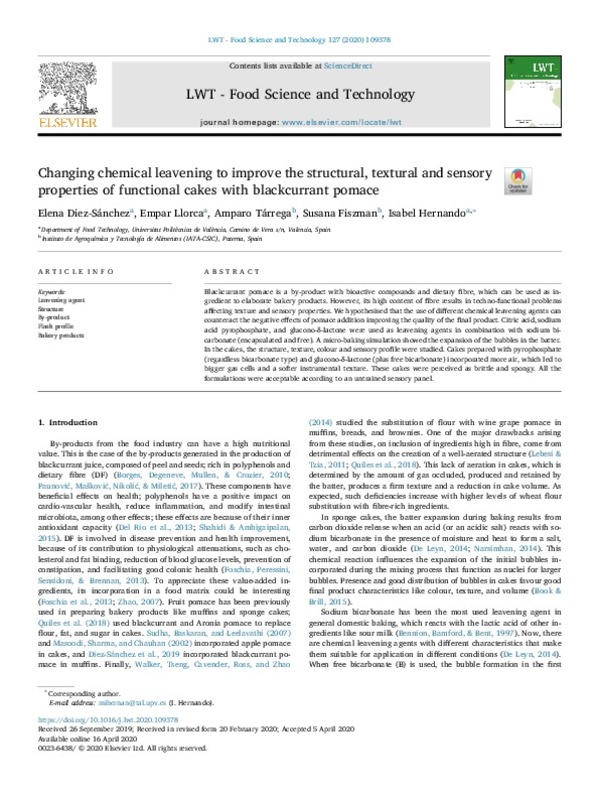JavaScript is disabled for your browser. Some features of this site may not work without it.
Buscar en RiuNet
Listar
Mi cuenta
Estadísticas
Ayuda RiuNet
Admin. UPV
Changing chemical leavening to improve the structural, textural and sensory properties of functional cakes with blackcurrant pomace
Mostrar el registro sencillo del ítem
Ficheros en el ítem
| dc.contributor.author | Díez-Sánchez, Elena
|
es_ES |
| dc.contributor.author | Llorca Martínez, Mª Empar
|
es_ES |
| dc.contributor.author | Tárrega, Amparo
|
es_ES |
| dc.contributor.author | Fiszman, Susana
|
es_ES |
| dc.contributor.author | Hernando Hernando, Mª Isabel
|
es_ES |
| dc.date.accessioned | 2021-07-30T03:31:17Z | |
| dc.date.available | 2021-07-30T03:31:17Z | |
| dc.date.issued | 2020-06 | es_ES |
| dc.identifier.issn | 0023-6438 | es_ES |
| dc.identifier.uri | http://hdl.handle.net/10251/170964 | |
| dc.description.abstract | [EN] Blackcurrant pomace is a by-product with bioactive compounds and dietary fibre, which can be used as ingredient to elaborate bakery products. However, its high content of fibre results in techno-functional problems affecting texture and sensory properties. We hypothesised that the use of different chemical leavening agents can counteract the negative effects of pomace addition improving the quality of the final product. Citric acid, sodium acid pyrophosphate, and glucono-delta-lactone were used as leavening agents in combination with sodium bicarbonate (encapsulated and free). A micro-baking simulation showed the expansion of the bubbles in the batter. In the cakes, the structure, texture, colour and sensory profile were studied. Cakes prepared with pyrophosphate (regardless bicarbonate type) and glucono-delta-lactone (plus free bicarbonate) incorporated more air, which led to bigger gas cells and a softer instrumental texture. These cakes were perceived as brittle and spongy. All the formulations were acceptable according to an untrained sensory panel. | es_ES |
| dc.description.sponsorship | The authors are grateful to Instituto Nacional de Investigacion y Tecnologia Agraria y Alimentaria (INIA-Spain) for financial support through the BERRYPOM - Adding value to fruit processing waste: innovative ways to incorporate fibres from berry pomace in baked and extruded cereal-based foods project included in the ERA-NET SUSFOOD programme. They would also like to thank Phillip John Bentley for his assistance in correcting the manuscript's English. They would also like to thank Phillip John Bentley for his assistance in correcting the manuscript's English. | es_ES |
| dc.language | Inglés | es_ES |
| dc.publisher | Elsevier | es_ES |
| dc.relation.ispartof | LWT - Food Science and Technology | es_ES |
| dc.rights | Reconocimiento - No comercial - Sin obra derivada (by-nc-nd) | es_ES |
| dc.subject | Leavening agent | es_ES |
| dc.subject | Structure | es_ES |
| dc.subject | By-product | es_ES |
| dc.subject | Flash profile | es_ES |
| dc.subject | Bakery products | es_ES |
| dc.subject.classification | TECNOLOGIA DE ALIMENTOS | es_ES |
| dc.title | Changing chemical leavening to improve the structural, textural and sensory properties of functional cakes with blackcurrant pomace | es_ES |
| dc.type | Artículo | es_ES |
| dc.identifier.doi | 10.1016/j.lwt.2020.109378 | es_ES |
| dc.relation.projectID | info:eu-repo/grantAgreement/EC/FP7/291766/EU/Sustainable Food/ | es_ES |
| dc.rights.accessRights | Abierto | es_ES |
| dc.contributor.affiliation | Universitat Politècnica de València. Instituto Universitario de Ingeniería de Alimentos para el Desarrollo - Institut Universitari d'Enginyeria d'Aliments per al Desenvolupament | es_ES |
| dc.contributor.affiliation | Universitat Politècnica de València. Departamento de Tecnología de Alimentos - Departament de Tecnologia d'Aliments | es_ES |
| dc.description.bibliographicCitation | Díez-Sánchez, E.; Llorca Martínez, ME.; Tárrega, A.; Fiszman, S.; Hernando Hernando, MI. (2020). Changing chemical leavening to improve the structural, textural and sensory properties of functional cakes with blackcurrant pomace. LWT - Food Science and Technology. 127:1-8. https://doi.org/10.1016/j.lwt.2020.109378 | es_ES |
| dc.description.accrualMethod | S | es_ES |
| dc.relation.publisherversion | https://doi.org/10.1016/j.lwt.2020.109378 | es_ES |
| dc.description.upvformatpinicio | 1 | es_ES |
| dc.description.upvformatpfin | 8 | es_ES |
| dc.type.version | info:eu-repo/semantics/publishedVersion | es_ES |
| dc.description.volume | 127 | es_ES |
| dc.relation.pasarela | S\408323 | es_ES |
| dc.contributor.funder | European Commission | es_ES |
| dc.contributor.funder | Instituto Nacional de Investigación y Tecnología Agraria y Alimentaria | es_ES |
| dc.description.references | Bellido, G. G., Scanlon, M. G., Sapirstein, H. D., & Page, J. H. (2008). Use of a Pressuremeter To Measure the Kinetics of Carbon Dioxide Evolution in Chemically Leavened Wheat Flour Dough. Journal of Agricultural and Food Chemistry, 56(21), 9855-9861. doi:10.1021/jf801125f | es_ES |
| dc.description.references | Book, S., & Brill, R. (2015). Effects of Chemical Leavening on Yellow Cake Properties. Cereal Foods World, 60(2), 71-75. doi:10.1094/cfw-60-2-0071 | es_ES |
| dc.description.references | Borges, G., Degeneve, A., Mullen, W., & Crozier, A. (2009). Identification of Flavonoid and Phenolic Antioxidants in Black Currants, Blueberries, Raspberries, Red Currants, and Cranberries. Journal of Agricultural and Food Chemistry, 58(7), 3901-3909. doi:10.1021/jf902263n | es_ES |
| dc.description.references | Dairou, V., & Sieffermann, J.-M. (2002). A Comparison of 14 Jams Characterized by Conventional Profile and a Quick Original Method, the Flash Profile. Journal of Food Science, 67(2), 826-834. doi:10.1111/j.1365-2621.2002.tb10685.x | es_ES |
| dc.description.references | Dewaest, M., Villemejane, C., Berland, S., Neron, S., Clement, J., Verel, A., & Michon, C. (2017). Effect of crumb cellular structure characterized by image analysis on cake softness. Journal of Texture Studies, 49(3), 328-338. doi:10.1111/jtxs.12303 | es_ES |
| dc.description.references | Diez-Sánchez, E., Quiles, A., Llorca, E., Reiβner, A.-M., Struck, S., Rohm, H., & Hernando, I. (2019). Extruded flour as techno-functional ingredient in muffins with berry pomace. LWT, 113, 108300. doi:10.1016/j.lwt.2019.108300 | es_ES |
| dc.description.references | DORKO, C. L., & PENFIELD, M. P. (1993). Melt Point of Encapsulated Sodium Bicarbonates: Effect on Refrigerated Batter and Muffins Baked in Conventionai and Microwave Ovens. Journal of Food Science, 58(3), 574-578. doi:10.1111/j.1365-2621.1993.tb04326.x | es_ES |
| dc.description.references | Foschia, M., Peressini, D., Sensidoni, A., & Brennan, C. S. (2013). The effects of dietary fibre addition on the quality of common cereal products. Journal of Cereal Science, 58(2), 216-227. doi:10.1016/j.jcs.2013.05.010 | es_ES |
| dc.description.references | F. Gibbs, Selim Kermasha, Inteaz Al, B. (1999). Encapsulation in the food industry: a review. International Journal of Food Sciences and Nutrition, 50(3), 213-224. doi:10.1080/096374899101256 | es_ES |
| dc.description.references | Godefroidt, T., Ooms, N., Pareyt, B., Brijs, K., & Delcour, J. A. (2019). Ingredient Functionality During Foam‐Type Cake Making: A Review. Comprehensive Reviews in Food Science and Food Safety, 18(5), 1550-1562. doi:10.1111/1541-4337.12488 | es_ES |
| dc.description.references | Lassoued, N., Delarue, J., Launay, B., & Michon, C. (2008). Baked product texture: Correlations between instrumental and sensory characterization using Flash Profile. Journal of Cereal Science, 48(1), 133-143. doi:10.1016/j.jcs.2007.08.014 | es_ES |
| dc.description.references | Lebesi, D. M., & Tzia, C. (2009). Effect of the Addition of Different Dietary Fiber and Edible Cereal Bran Sources on the Baking and Sensory Characteristics of Cupcakes. Food and Bioprocess Technology, 4(5), 710-722. doi:10.1007/s11947-009-0181-3 | es_ES |
| dc.description.references | Masoodi, F. A., Sharma, B., & Chauhan, G. S. (2002). Plant Foods for Human Nutrition, 57(2), 121-128. doi:10.1023/a:1015264032164 | es_ES |
| dc.description.references | Meiners, J. A. (2012). Fluid bed microencapsulation and other coating methods for food ingredient and nutraceutical bioactive compounds. Encapsulation Technologies and Delivery Systems for Food Ingredients and Nutraceuticals, 151-176. doi:10.1533/9780857095909.2.151 | es_ES |
| dc.description.references | Narsimhan, G. (2014). A mechanistic model for baking of leavened aerated food. Journal of Food Engineering, 143, 80-89. doi:10.1016/j.jfoodeng.2014.06.030 | es_ES |
| dc.description.references | Paunović, S. M., Mašković, P., Nikolić, M., & Miletić, R. (2017). Bioactive compounds and antimicrobial activity of black currant ( Ribes nigrum L.) berries and leaves extract obtained by different soil management system. Scientia Horticulturae, 222, 69-75. doi:10.1016/j.scienta.2017.05.015 | es_ES |
| dc.description.references | Quiles, A., Llorca, E., Schmidt, C., Reißner, A.-M., Struck, S., Rohm, H., & Hernando, I. (2018). Use of berry pomace to replace flour, fat or sugar in cakes. International Journal of Food Science & Technology, 53(6), 1579-1587. doi:10.1111/ijfs.13765 | es_ES |
| dc.description.references | Reißner, A.-M., Al-Hamimi, S., Quiles, A., Schmidt, C., Struck, S., Hernando, I., … Rohm, H. (2018). Composition and physicochemical properties of dried berry pomace. Journal of the Science of Food and Agriculture, 99(3), 1284-1293. doi:10.1002/jsfa.9302 | es_ES |
| dc.description.references | Rodríguez-García, J., Puig, A., Salvador, A., & Hernando, I. (2013). Funcionality of several cake ingredients: A comprehensive approach. Czech Journal of Food Sciences, 31(No. 4), 355-360. doi:10.17221/412/2012-cjfs | es_ES |
| dc.description.references | Rodríguez-García, J., Salvador, A., & Hernando, I. (2013). Replacing Fat and Sugar with Inulin in Cakes: Bubble Size Distribution, Physical and Sensory Properties. Food and Bioprocess Technology, 7(4), 964-974. doi:10.1007/s11947-013-1066-z | es_ES |
| dc.description.references | Shahidi, F., & Ambigaipalan, P. (2015). Phenolics and polyphenolics in foods, beverages and spices: Antioxidant activity and health effects – A review. Journal of Functional Foods, 18, 820-897. doi:10.1016/j.jff.2015.06.018 | es_ES |
| dc.description.references | Sudha, M. L., Baskaran, V., & Leelavathi, K. (2007). Apple pomace as a source of dietary fiber and polyphenols and its effect on the rheological characteristics and cake making. Food Chemistry, 104(2), 686-692. doi:10.1016/j.foodchem.2006.12.016 | es_ES |
| dc.description.references | Tarrega, A., Rizo, A., & Fiszman, S. (2017). Sensory space of battered surimi rings: Key features determined by Flash Profiling. Journal of Sensory Studies, 32(4), e12274. doi:10.1111/joss.12274 | es_ES |
| dc.description.references | Walker, R., Tseng, A., Cavender, G., Ross, A., & Zhao, Y. (2014). Physicochemical, Nutritional, and Sensory Qualities of Wine Grape Pomace Fortified Baked Goods. Journal of Food Science, 79(9), S1811-S1822. doi:10.1111/1750-3841.12554 | es_ES |
| dc.description.references | Wilderjans, E., Luyts, A., Brijs, K., & Delcour, J. A. (2013). Ingredient functionality in batter type cake making. Trends in Food Science & Technology, 30(1), 6-15. doi:10.1016/j.tifs.2013.01.001 | es_ES |









